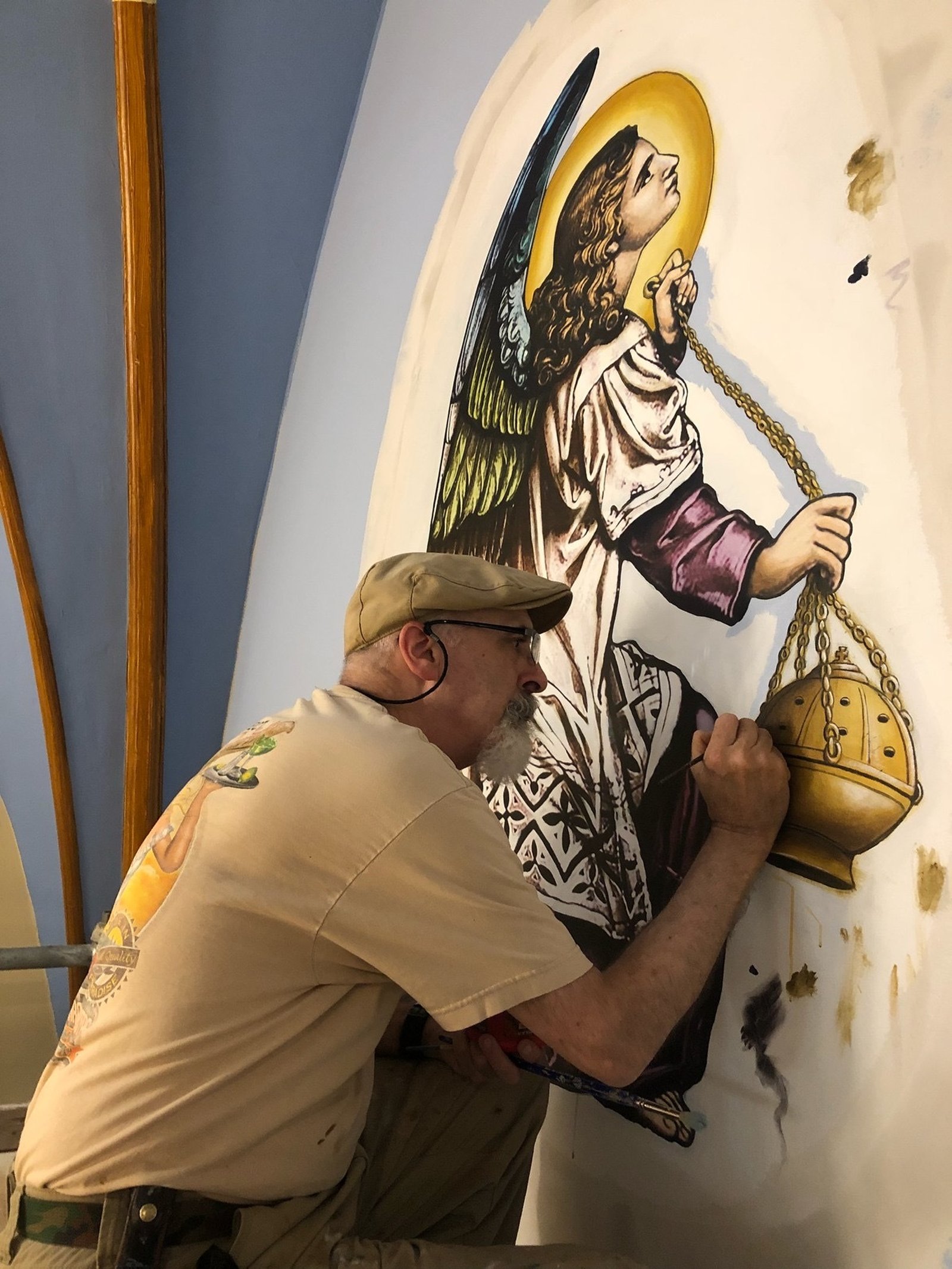New paint scheme, installation of confessionals brings a timeless charm to Romanesque church
ERIE ─ St. Joseph Parish in Erie got some T.L.C. this summer – tender loving care – or more aptly, traditional liturgical craftmanship.
The rural parish installed permanent confessionals, got a new coat of paint for the first time in 20 years, and repaired the walls in the sanctuary.
The renovations give the parish a look that is more in-tune with the original design of church that was built in 1847.
Fr. Robert Slaton, the moderator of the Lumen Christi Family of Parishes (which includes St. Joseph, Our Lady of Mount Carmel in Temperance and St. Anthony in Temperance) first noticed water damage to walls and brick work 12 years ago.
“I remember 12 years ago, I was sent down here as a young associate and they had me cover a Mass at St. Joseph, because I was at the neighboring parish Mount Carmel,” Fr. Slaton told Detroit Catholic. “There was this water damage in the drywall behind the altar in sanctuary, and I thought someone really needed to fix that. Eight years later, they send me down here as the pastor of St. Anthony, and when I came to visit St. Joseph, lo and behold, that same water damage was still here. I must admit, I was a little upset, it ached my heart.”
Fortunately for Fr. Slaton, the St. Joseph community under its previous pastor had already set aside funds for repairs from donations to the Central Services Appeal that succeeded the parish’s goal.

Fr. Slaton reached out to Jeffrey Duchene, a Lansing-based artist who did previous work for Fr. Slaton at St. Anthony's, to see what he could do for the church.
But there was a small hiccup.
“He had sworn to me five years ago, when he painted St. Anthony’s, that it would be his last project, that he was going to retire,” Fr. Slaton said. “I was delighted when I called him up and asked how retirement was. He said, ‘I tried, Father, but I couldn’t do it.’ So, we got him down here, showed him the church, and he got ideas right away.”
Fr. Slaton and Duchene discussed the renovation project, what Fr. Slaton preferred, and Duchene detailing unique aspects of the Romanesque-style church with its vaulted ceilings and arches.
Beyond giving the church a new coat of paint, Duchene wanted the renovation to harken back to the original style of the parish.
“We were looking back at old photographs because there were so many different paint schemes and designs done at the church through the years, layer after layer,” Duchene said. “We went back to what the church originally looked like in the Victorian Era, with these dark colors and tons of designs. To me, even though that was the first paint job, it wasn’t architecturally correct. So we went with a more architecturally correct paint scheme with the colors and art work in the nave with the four evangelists.”
Fr. Slaton and Duchene settled on a rich, warm red color for the wall behind the high altar in the sanctuary, flanked by golden-yellow walls on the side of the sanctuary that contrast with the two marble altars.
In order to paint the four evangelists in the sanctuary, Duchene would have to remove two murals that flanked the sanctuary. As he got a closer look at the murals, he noticed they had a familiar look to them.

“I kept looking up and thinking how they looked so familiar,” Duchene said. “And then I saw the name in the corner of the murals: Matthew Duchene.”
The murals were completed by Duchene’s brother in the 1990s and were some of the last pieces of work he completed before he died.
It was Matthew who got Duchene into renovating churches after retiring from his job as a painter at the Fisher Building in Detroit, so he knew he couldn’t just paint over the murals.
“I was thinking, ‘Uh oh, I was going to be removing this and putting up my own painting,’” Duchene said. “But they were quite heavily damaged, and again, they didn’t fit the paint scheme going on in the church with the architectural idea we needed for the church. So we removed the murals, I had them rolled up on (they are on canvass) and they will possibly put them up in a different part of the church, just not sure right now.”
Fr. Slaton said the reaction to the renovative paint job has been a positive one, with the church having a warmer feeling, particularly when the sun pierces through the church’s windows.
The church sought feedback from parishioners throughout the process, with an older parishioner recalling the church used to have a giant cross painted on the ceiling that extended down the entire aisle of the church.
“This woman came up to us and said during her First Communion, she remembers looking up and seeing a large cross on the ceiling, and she was asking if there was any way we could bring that back,” Fr. Slaton said. “I talked to Jeff about it, and lo and behold, we got a cross on the ceiling. It’s not as big as the original, which ran the entire length of the church, but I liked it as soon as I saw what Jeff had done with it.”

Duchene wasn’t the biggest fan of the ceiling cross at first. The original cross was apparently blue (the parish staff couldn’t find photographic of the cross), was the width of the aisle and ran down to the choir.
“I said no way, we can’t put a big blue cross up there, it would be awful and I would go against the entire paint scheme of the church,” Duchene said. “But Fr. Slaton said we needed to put a cross up there. I said I’ll do a smaller cross up there, make it look wood and highlight the four ends of the cross with some ornamental golden leaves, and that turned out really good.”
Late editions aside, the renovations seem to be a big hit at the parish.
The original cornerstone of St. Joseph’s was laid in 1819, making it the third-oldest parish in the Archdiocese of Detroit, behind the Basilica of Ste. Anne de Detroit and St. Mary Parish in Monroe.
The current church built in 1847 with various renovations since then, the most recent being the paint job completed by Matthew Duchene in the late 1990s.
“My favorite part of this renovation has been watching the history unfold,” said Grace Ledbetter, mission supporter director for the Lumen Christi Family of Parishes. “Not only for our older parishioners who remember this is what the church used to look like, but to our younger generations who see how much work has gone into this church. This parish has been around for so long, so many families have been around since 1819, so we have generations who have been involved in this parish.”
Fr. Louis Lapeyre, is the priest In Solidum assigned to St. Joseph, arriving to the church in July from Our Lady on the River Parish in Marine City.

Fr. Lapeyre arrived to a church that was full of scaffolding amidst the painting, but there definitely an added benefit to preaching in church that just had some work done.
"The great thing about the renovations is you are working with things that are new,” Fr. Lapeyre said. “It’s an opportunity to refocus on encountering God in the new and what is now newly present here. I remember one Sunday, talking about St. Joseph being greeted by the angels and the role he would take in Matthew’s Gospel, and just looking at the angels Jeffrey has painted on the sanctuary walls and use that in my preaching, it helps bring the Gospel to life.”
Fr. Slaton has preached to the congregation not only about why the renovations were important to complete from a physical standpoint, but why worshiping in spaces that are beautiful is important spiritually.
“A church building is ultimately a place where you worship God, it is what it in essence,” Fr. Slaton said. “Some might say functionality is the only thing that matters, just have a church with a cross on the wall and you’re done. But I think I have more of a mindset that people have been trying to glorify God through beauty as far as back as we have a written record of trying to glorify God.
“While we are never going to recreate the beauty and glory of heaven I this world, I think even attempting to do so please our Lord,” Fr. Slaton continued. “It gives people something that lifts their mind and heart by looking at depictions, Biblical scenes, holy imagery and beauty in an abstract way that lifts our minds and hearts towards something greater, something purer, something we can experience in this world that leaves a lasting impression.”
Duchene said the color scheme of the church is what he’s most proud of, noting the dark, rich color of the walls work well with the arched windows of the Romanesque church to create a worship space that is both intimate and timeless.

“Working with Fr. Slaton, the decisions we made were about providing a space that inspires people to prayer, that’s the main thing,” Duchesne said. “People will walk in and see all the art and see it has a warm, inspiring feeling. If people look at the church and can’t imagine it would look like anything else, that’s how I know I did a good job.”
Coupled with the recent addition of confessionals in the church proper – confessions were heard in the sacristy, which has an external door and led to a situation Fr. Slaton never thought was ideal – along with changes in church lighting to complement the new paint scheme of the church.
In total, the renovations have come out to $110,000.
Before the project began, Fr. Slaton said the biggest concern was to keep the church renovations as close to its original design as possible, a simple Romanesque church in a rural corner of the Southeast Michigan where the people of God of Erie can come worship.
To bring revival to something that is timeliness.
Fr. Slaton thinks the renovations have done just that.
“Our faith is ancient, so when you take something and renew it in the proper sense, you make it look fresh, you make it look as if it doesn’t have decades of wear and tear upon it, but you don’t’ attempt to make it look contemporary,” Fr. Slaton said. “You make it look like the era from which it was conceived.
“What strikes me is that is the Gospel message,” Fr. Slaton said. “We can’t make it new, but we can renew it and present it in a way that makes it applicable to the contemporary mindset without making it something completely novel. I’m reminded of that constantly when I look at what we’ve done here. We haven’t tried to make it look like a brand-new building, but we renewed what was given to us from previous generations.”











